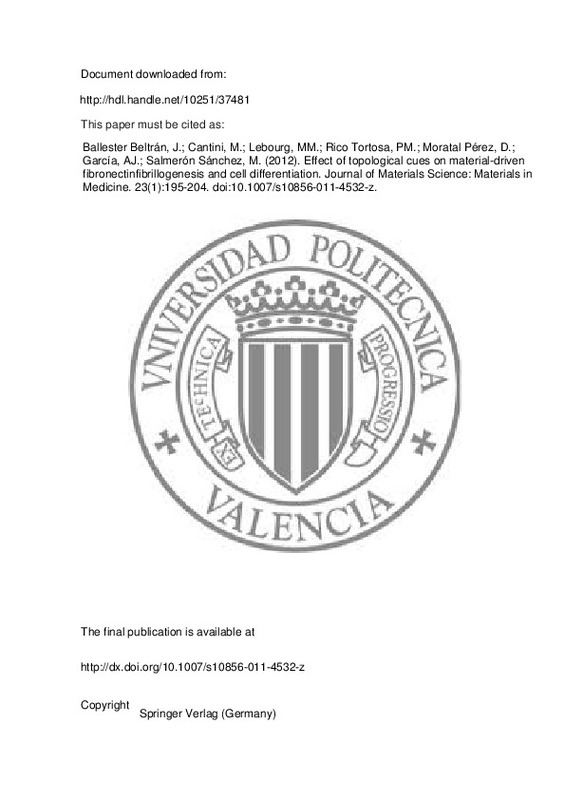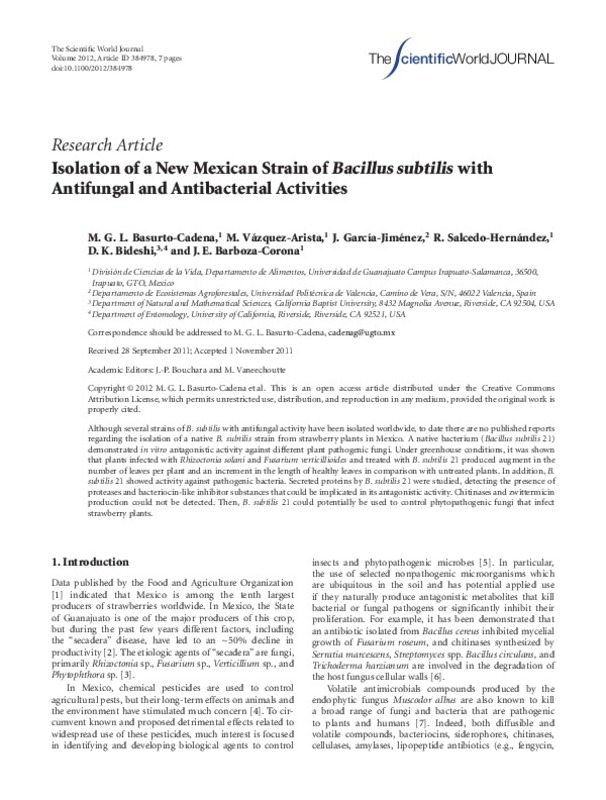Salmerón Sánchez, M.; Rico Tortosa, PM.; Moratal Pérez, D.; Lee, TT.; Schwarzbauer, JE.; Garcia, AJ. (2011). Role of material-driven fibronectin fibrillogenesis in cell differentiation. Biomaterials. 32(8):2099-2105. https://doi.org/10.1016/j.biomaterials.2010.11.057
Por favor, use este identificador para citar o enlazar este ítem: http://hdl.handle.net/10251/33174
|
Título:
|
Role of material-driven fibronectin fibrillogenesis in cell differentiation
|
|
Autor:
|

 Salmerón Sánchez, Manuel
Salmerón Sánchez, Manuel
 Rico Tortosa, Patricia María
Rico Tortosa, Patricia María

 Moratal Pérez, David
Lee, Ted T.
Schwarzbauer, Jean E.
Garcia, Andres J.
Moratal Pérez, David
Lee, Ted T.
Schwarzbauer, Jean E.
Garcia, Andres J.
|
|
Entidad UPV:
|
Universitat Politècnica de València. Departamento de Ingeniería Electrónica - Departament d'Enginyeria Electrònica
Universitat Politècnica de València. Departamento de Física Aplicada - Departament de Física Aplicada
|
|
Fecha difusión:
|
|
|
Resumen:
|
Fibronectin (FN) is a ubiquitous extracellular matrix protein (ECM) protein that is organized into fibrillar networks by cells through an integrin-mediated process that involves contractile forces. This assembly allows for ...[+]
Fibronectin (FN) is a ubiquitous extracellular matrix protein (ECM) protein that is organized into fibrillar networks by cells through an integrin-mediated process that involves contractile forces. This assembly allows for the unfolding of the FN molecule, exposing cryptic domains that are not available in the native globular FN structure and activating intracellular signalling complexes. However, organization of FN into a physiological fibrillar network upon adsorption on a material surface has not been observed. Here we demonstrate cell-free, material-induced FN fibrillogenesis into a biological matrix with enhanced cellular activities. We found that simple FN adsorption onto poly(ethyl acrylate) surfaces, but not control polymers, triggered FN organization into a fibrillar network via interactions in the amino-terminal 70 kDa fragment, which is involved in the formation of cell-mediated FN fibrils. Moreover, the material-driven FN fibrils exhibited enhanced biological activities in terms of myogenic differentiation compared to individual FN molecules and even type I collagen. Our results demonstrate that molecular assembly of FN can take place at the material interface, giving rise to a physiological protein network similar to fibrillar matrices assembled by cells. This research identifies material surfaces that trigger the organization of extracellular matrix proteins into biological active fibrils and establishes a new paradigm to engineer ECM-mimetic biomaterials.
[-]
|
|
Palabras clave:
|
Cell adhesion
,
Fibronectin
,
Integrin
,
Interface
,
Biological activities
,
Biological matrixes
,
Cell-free
,
Cellular activities
,
Contractile force
,
Extracellular matrix protein
,
Fibrillar networks
,
Fibrillogenesis
,
In-cell
,
Integrins
,
Intracellular signalling
,
Material interfaces
,
Material surface
,
Molecular assembly
,
Poly (ethyl acrylate)
,
Protein network
,
Type I collagen
,
Adhesion
,
Adsorption
,
Complexation
,
Enzyme activity
,
Materials
,
Molecular interactions
,
Physiology
,
Surface properties
,
Tissue
,
Proteins
,
Acrylic acid ethyl ester
,
Biomaterial
,
Collagen fibril
,
Collagen type 1
,
Polymer
,
Amino terminal sequence
,
Animal cell
,
Article
,
Biological activity
,
Cell activity
,
Cell differentiation
,
Controlled study
,
Muscle cell
,
Muscle development
,
Nonhuman
,
Priority journal
,
Protein assembly
,
Protein protein interaction
,
Acrylic Resins
,
Animals
,
Biocompatible Materials
,
Bone Cements
,
Cell Line
,
Extracellular Matrix
,
Fibronectins
,
Focal Adhesion Protein-Tyrosine Kinases
,
Humans
,
Materials Testing
,
Mice
,
Microscopy, Atomic Force
,
Polymethyl Methacrylate
|
|
Derechos de uso:
|
Cerrado |
|
Fuente:
|
Biomaterials. (issn:
0142-9612
)
|
|
DOI:
|
10.1016/j.biomaterials.2010.11.057
|
|
Editorial:
|
Elsevier
|
|
Versión del editor:
|
http://dx.doi.org/10.1016/j.biomaterials.2010.11.057
|
|
Código del Proyecto:
|
info:eu-repo/grantAgreement/MICINN//MAT2009-14440-C02-01/ES/Dinamica De Las Proteinas De La Matriz En La Interfase Celula-Material/
info:eu-repo/grantAgreement/ME//PR2009-0351/ES/PR2009-0351/
info:eu-repo/grantAgreement/NSF//F DMR-0909002/
|
|
Agradecimientos:
|
This work was supported by NSF DMR-0909002 and MAT2009-14440-C02-01. MSS was supported by the Spanish Government through PR2009-0351 to stay in Atlanta (Georgia Institute of Technology) for a sabbatical during 2010.
|
|
Tipo:
|
Artículo
|






![[Cerrado]](/themes/UPV/images/candado.png)




